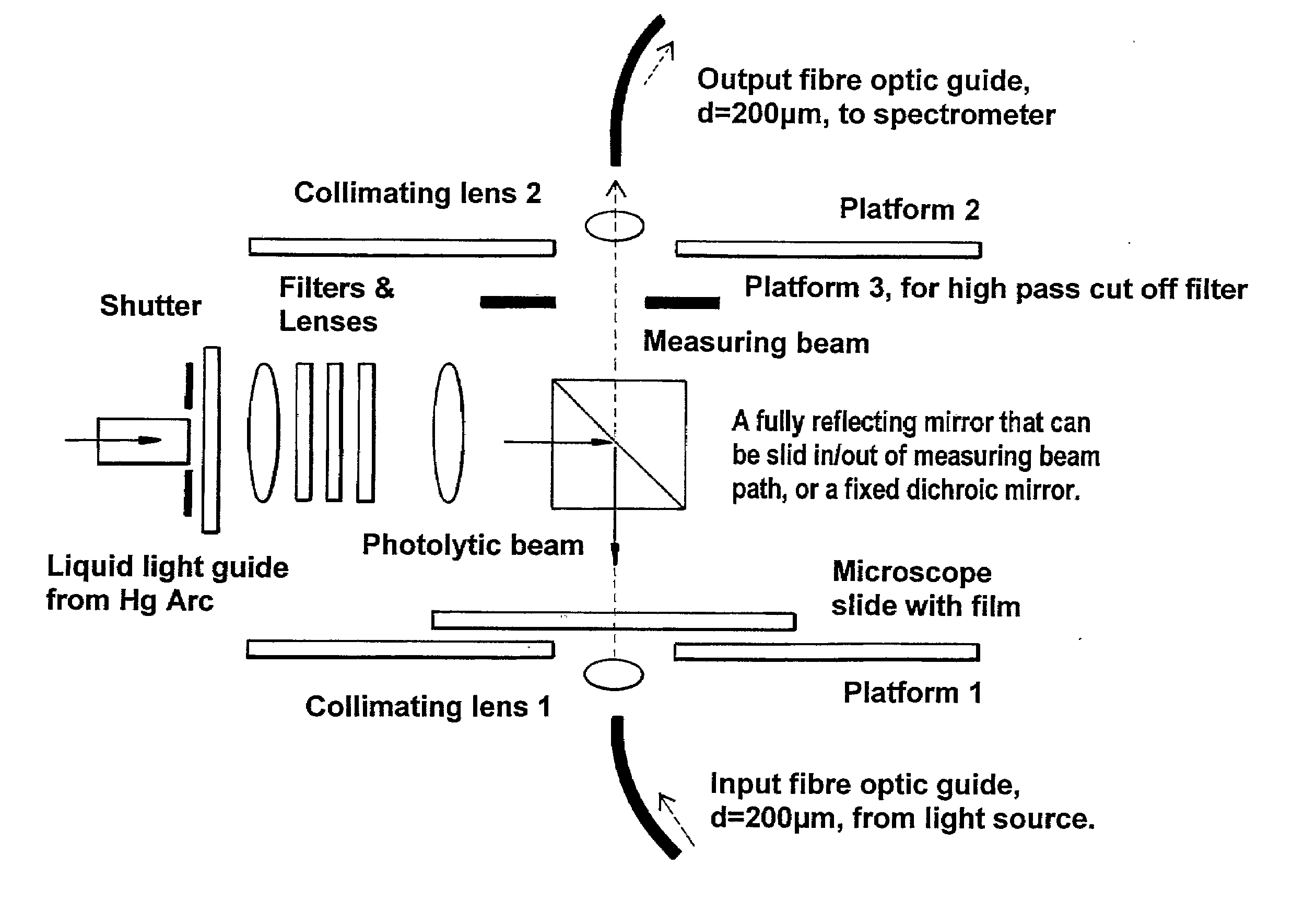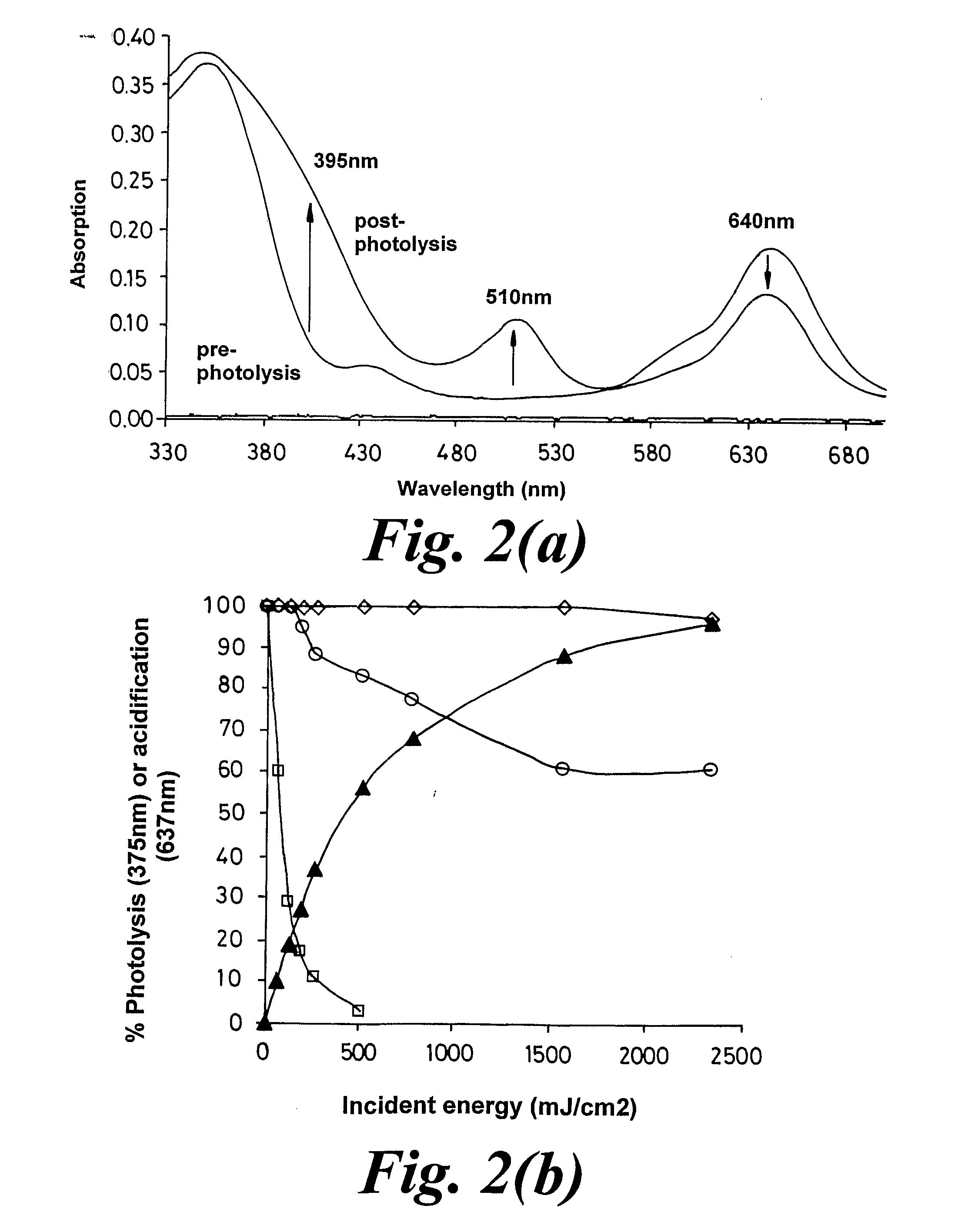Materials and Methods for the Photodirected Synthesis of Oligonucleotide Arrays
a technology of oligonucleotide arrays and materials, applied in the field of oligonucleotide array synthesis, can solve the problems of reduced synthesis efficiency, high production cost, and high cost, and achieves the effects of increasing the intrafilm diffusion coefficient, weak molecular weight dependence, and increasing the concentration of residual solvents
- Summary
- Abstract
- Description
- Claims
- Application Information
AI Technical Summary
Benefits of technology
Problems solved by technology
Method used
Image
Examples
example 1
Photoacid-Dependent Detritylation of 5′DMT-O-Thymidine Covalently Attached to a Glass Microscope Slide at Moderate Density
[0279]Attachment of DMT-T to glass slides. We followed literature methods to attach linkers and mononucleotides to glass. Slides derivatized with 3-aminopropyltriethoxysilane were either purchased from Sigma-Aldrich or prepared in our laboratory. We followed literature procedures to prepare (a) 5′-O-DMT-3′-O-succinylthymidine by reaction of commercially available 5′-DMT-O-thymidine with succinic anhydride in the presence of dimethylaminopyridine in dry pyridine, and (b) 5′-O-dimethoxy-trityl-3′-O-succinyl-(p-nitrophenyl)-thymidine by the condensation of 5′-O-DMT-3′-O-succinyl-thymidine with p-nitrophenol in the presence of dicyclohexylcarbodiimide (DCC) in dioxane. As an alternative, used in Example 2, glass slides were derivatised with 3-glycidoxypropyltrimethoxysilane followed by ethylene glycol or hexaethylene glycol to provide a terminal primary hydroxyl grou...
example 2
[0282]Photoacid-dependent detritylation of 5′-O-DMT-Thymidine covalently attached to a glass microscope slide at high density. Coupling of mononucleotides to glass slides derivatised with 3-glycidoxypropyltrimethoxysilane. Rectangular pieces of derivatised slide were placed in a round bottom flask and treated with 5′-O-DMT-thymidine-3′-O-phosphoramidite (0.25 g) in dry acetonitrile (5 mL) and activator solution (5 mL of 0.25 M tetrazole in acetonitrile, from Applied Biosystems) added under argon. The reaction was stirred vigorously at rt for 10 minutes and exposed to ultrasound for 5 min. The slides were washed thoroughly with dry acetonitrile and treated with the oxidiser solution (25 mL), from Applied Biosystems, for 60 sec at rt. After being washed again with dry acetonitrile the slides were treated with the Cap A and Cap B solution (1:1 v / v, 25 mL), from Applied Biosystems, and finally washed thoroughly with dry DMF, dioxane, methanol, acetonitrile, acetone, and diethyl ether an...
example 3
Use of Plasticizers to Increase Intrafilm Diffusion Coefficients
[0284]Examples 1 and 2 are with photoacid generating films composed entirely of the photoacid generator. Such films permit a low molecular weight compound such as trichloroacetic acid to undergo translational diffusion with a diffusion coefficient of c.20-30 nm2 s−1 at room temperature. This is not the case with films composed mainly of a polymer such as poly(α-methylstyrene), where the diffusion coefficient of trichloroacetic acid is 2 s−1. We carried out experiments using DMT-T attached to glass slides as in Example 2, dip-coated with a 1-1.5 μm thick film from a dichloromethane solution containing poly(α-methylstyrene) of average mol.wt. 2,000, the trichloroacetate ester of α-phenyl-4,5-dimethoxy-2,6-dinitro-benzyl alcohol, and triphenylmethane (as the plasticizer) in the ratio 8:4:1 by weight and an overall solute content of c.2% (wt / vol).
[0285]The diffusion coefficient at 20-23° C. for trichloroacetic acid in such ...
PUM
| Property | Measurement | Unit |
|---|---|---|
| Volume | aaaaa | aaaaa |
| Volume | aaaaa | aaaaa |
| Volume | aaaaa | aaaaa |
Abstract
Description
Claims
Application Information
 Login to View More
Login to View More - R&D
- Intellectual Property
- Life Sciences
- Materials
- Tech Scout
- Unparalleled Data Quality
- Higher Quality Content
- 60% Fewer Hallucinations
Browse by: Latest US Patents, China's latest patents, Technical Efficacy Thesaurus, Application Domain, Technology Topic, Popular Technical Reports.
© 2025 PatSnap. All rights reserved.Legal|Privacy policy|Modern Slavery Act Transparency Statement|Sitemap|About US| Contact US: help@patsnap.com



